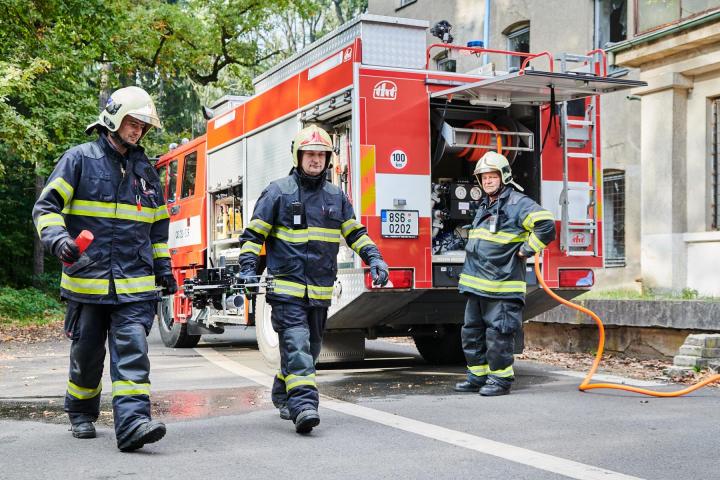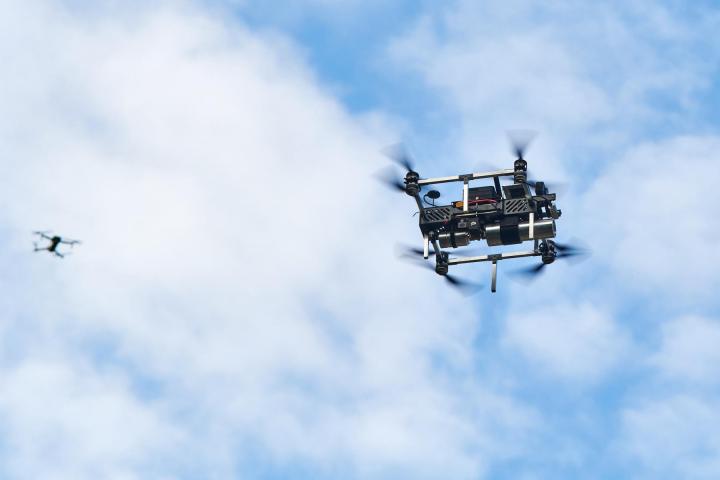
The drone, named DOFEC (Discharging Of Fire Extinguishing Capsules), was developed for the purpose of fighting fires in high-rise and multi-storey buildings. "With the help of on-board sensors and artificial intelligence, the drone detects and locates the fire using an infrared camera. Then, with the help of a special mechanism, it shoots a half-kilogram capsule with a substance into the fire site, which removes heat from the fire and reduces its intensity. This gives firefighters more time to reach the higher floors and save lives," explained the principle of the revolutionary firefighting system doc. Martin Saska, head of the Multirobotic Systems (MRS) group at the Department of Cybernetics at the CTU Faculty of Engineering.
According to available information, no similar system has been deployed anywhere in the world. Its creators are sizing the extinguishing drone so that in the future it can very accurately inject up to six capsules into a fire at once. The precise placement of the capsules through a window, which the drone will break itself in the future, is made possible primarily by advanced autonomous flight, stabilisation and thermal imaging software. Roboticists from FEL have been working on the development of this complex system since 2019. Testing in Brandýs nad Labem revealed that there was a reflection of the GPS signal in the vicinity of buildings, which complicated the drone's navigation at the intervention site. For the next prototype, the MRS group therefore envisages using on-board sensors to locate the drone so that it does not have to rely on the GPS signal.
Student Vojtěch Nydrle participated in the hardware design of the drone, whose production cost is estimated by researchers in the lower hundreds of thousands of crowns, as part of his bachelor's thesis. He used the program to design the size of the propellers or batteries and then the individual parts made of carbon composites and aluminium profiles. "I was making the drone in my workshop at home at the time of the pandemic. There was a long wait for parts, the actual assembly was already fast. The nine-kilogram drone is powered by electric motors and can stay in the air for about ten minutes," said the student, who is currently in the second year of the Master's programme in Cybernetics and Robotics at the FEL. Vojtěch Nydrle and his colleagues from the Multirobotic Systems group are already working on the development of a more advanced prototype drone that can carry six fire extinguishing capsules instead of just one, and will thus be able to put out a fire in a sixty-square-metre apartment.
The fact that the new solution has the potential to fundamentally change the way firefighters intervene in high-rise buildings is also acknowledged by a representative of the Central Bohemian Region Fire Brigade: "We very much appreciate the fact that we were invited by researchers from the Faculty of Electrical Engineering of the Czech Technical University to do this research, we see it as the embryo of a possible future, which still needs to be finalized from several aspects, not only from a technical and legal point of view, but also from a tactical point of view," said Jaroslav Gabriel, director of the Mělník fire department.
The use of drones within fire protection units in the Czech Republic has a future ahead of it. Currently, firefighters use drones for monitoring the intervention site, drones are equipped with a camera and infrared camera as standard, but they are not used for firefighting. According to Jaroslav Gabriel, due to the current payload and smaller volume of extinguishing agent, drones seem to be promising for extinguishing in smaller rooms. For larger rooms, reducing the intensity of the fire and gaining time for evacuation can be beneficial. In addition to the Central Bohemian Region Fire Brigade, the Multirobotic Systems group from FEL CTU has established cooperation with their colleagues from the Pilsen Region. The possibilities of using autonomous drones in firefighting are quite promising. In addition to the aforementioned firefighting, they can help in searching for people or dangerous objects (e.g. gas cylinders).
The MRS Group's competence in this area is based on the experience of the MBZIRC competition in Abu Dhabi, where firefighting in a multi-storey building was one of the competition disciplines. The Czech team in the competition, which is considered the unofficial world championship of autonomous drones, has long been among the absolute world leaders and won it last year.
"During the technically very demanding flight in a smoky environment, we can rely on our experience in searching underground complexes in the DARPA Subterrenean Challenge, which our drones participated in as part of the broader FEL CTU robotics team performing under the CTU-CRAS-NORLAB banner," added Martin Saska. At the recent finals in Kentucky, the team from FEL took the silver in the virtual part and finished sixth in the physical robot competition.
Photo, courtesy of: Petr Neugebauer, Fakulta elektrotechnická ČVUT

